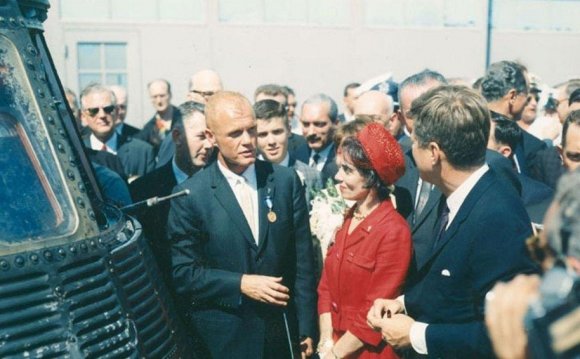

Ingenuity and Determination Propelled the Soviets Ahead in the Early Phase of the Space Race
Soviet and American space exploration accomplishments:
The pioneering engineers and scientists behind Explorer I celebrate the launch
- First satellite to orbit Earth, Sputnik 1
- First animal to enter Earth orbit, the dog Laika, Sputnik 2
- Launch of the first U.S. orbital satellite, the Explorer 1 spacecraft
- First man-made object to pass near the Moon, Luna 1
- First images of the Moon's far side, Luna 3
- Gemini 7-Astronauts Frank Borman and Jim Lovell spend two weeks in Earth orbit, which is the longest spaceflight until 1971, and perform the first successful orbital rendezvous between crewed spacecraft with Gemini 6
- Voskhod 2-Cosmonaut Alexei Leonov performs the first extravehicular activity
- First probe to make a soft landing on the Moon, Luna 9
- First probe in lunar orbit, Luna 10
- Gemini 8-Astronauts Neil Armstrong and Dave Scott perform the first successful crewed orbital rendezvous and docking
- Apollo 8-Astronauts Frank Borman, Jim Lovell, and Bill Anders become the first humans to orbit the Moon
- Apollo 11-Astronauts Neil Armstrong and Buzz Aldrin perform the first human lunar landing
- First robotic sample return from the Moon, Luna 16 (Soviet Union)
- First robotic space rover on the Moon, Lunokhod 1 (Soviet Union)
 Ranger
Ranger
Surveyor
Following Sputnik, the U.S. launched its first successful satellite, Explorer 1, in January 1958. Instruments on Explorer 1 first detected the intense radiation bands that surround the Earth, now called the Van Allen radiation belts.
Landmark U.S. Robotic Missions
By 1958, NASA, the newly created National Aeronautics and Space Administration, led U.S. efforts to explore space and prepare for future human missions to the Moon. Three important robotic programs were conducted from 1959-1969 to prepare for the first human landing:
- Ranger, to collect the first close-up images of the surface of the Moon;
- practica
- Lunar Orbiter, to map the lunar surface before the Apollo landings; and,
- Surveyor, to perform soft landings on the Moon.
Ranger Missions (1961-1965)
Ranger missions (1-9) were the first U.S. attempt to obtain close-up images of the Moon. Images were taken and transmitted to Earth up to the final moments before impact.
Lunar Orbiter Missions (1966-1967)
The Lunar Orbiter spacecraft (1-5) successfully photographed 99% of the Moon's surface and imaged 20 potential lunar landing sites proposed for the Surveyor and Apollo missions.
Surveyor Missions (1966-1968)
The Surveyor probes (1, 3, 5-7) were the first U.S. spacecraft to land safely on the Moon. Their objectives were to obtain close-up images of the surface and to determine if the terrain was safe for manned landings.RELATED VIDEO












